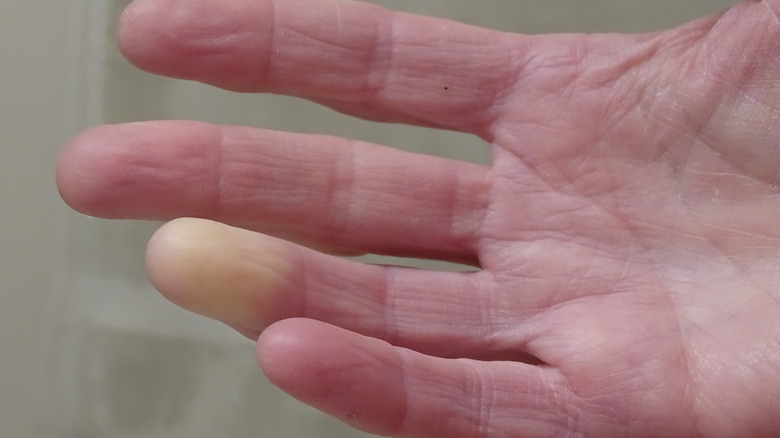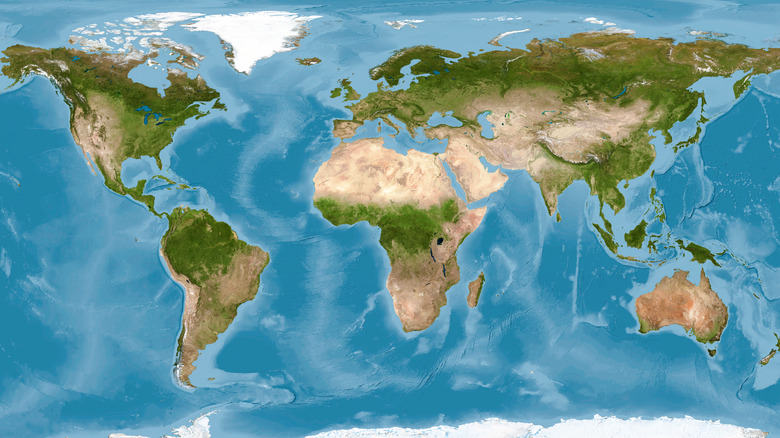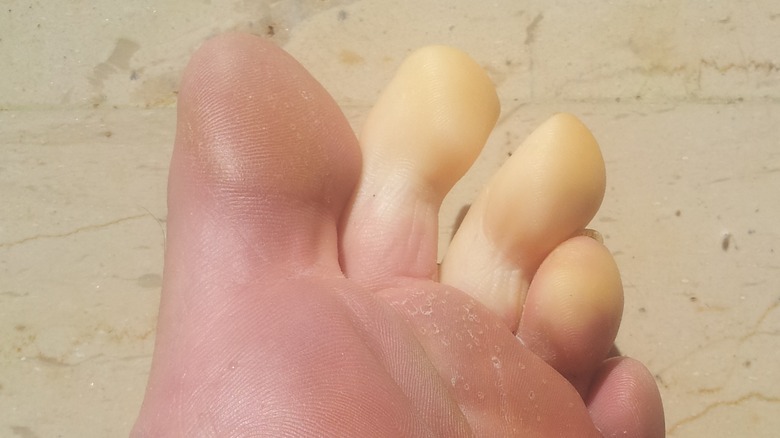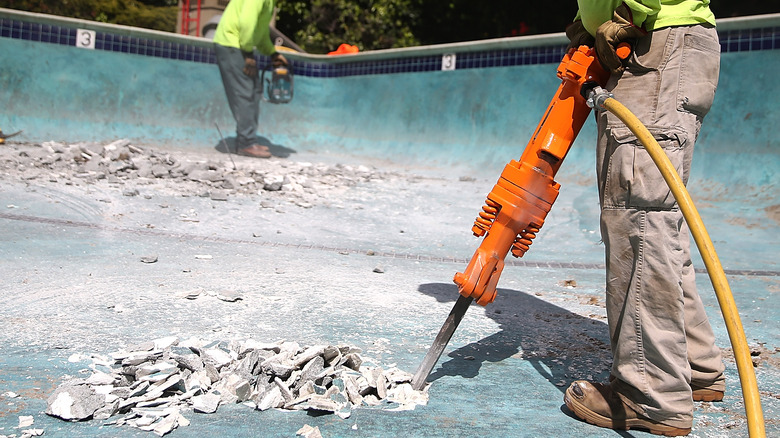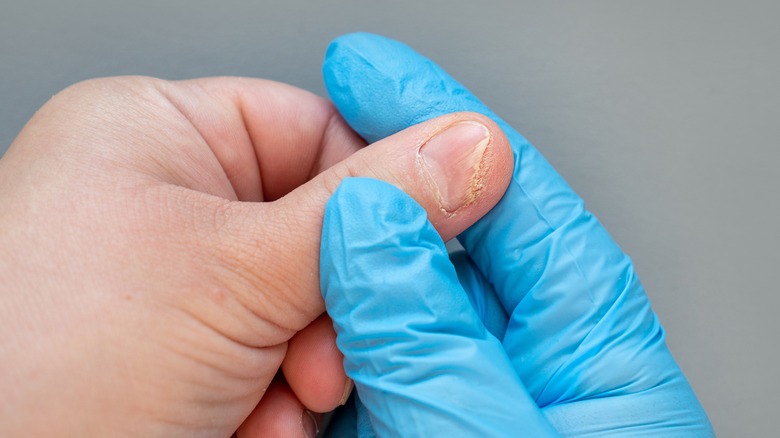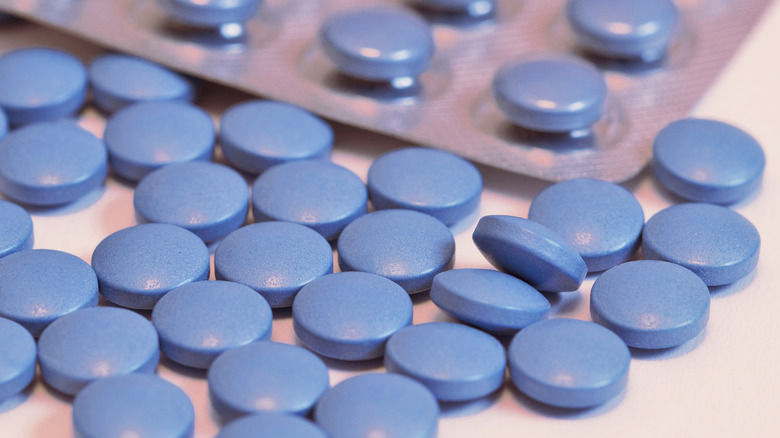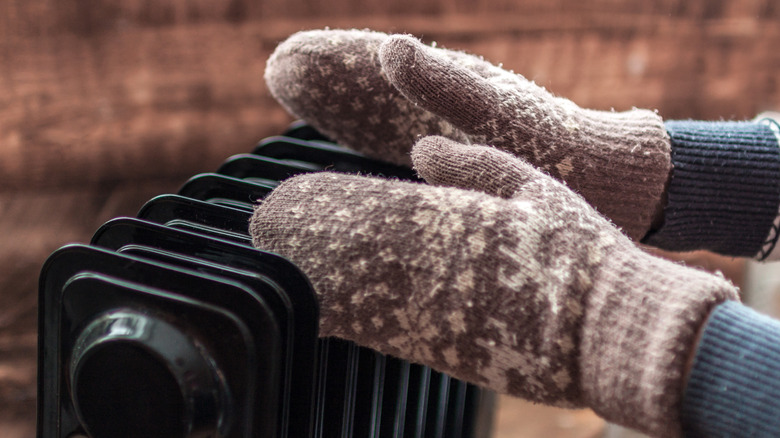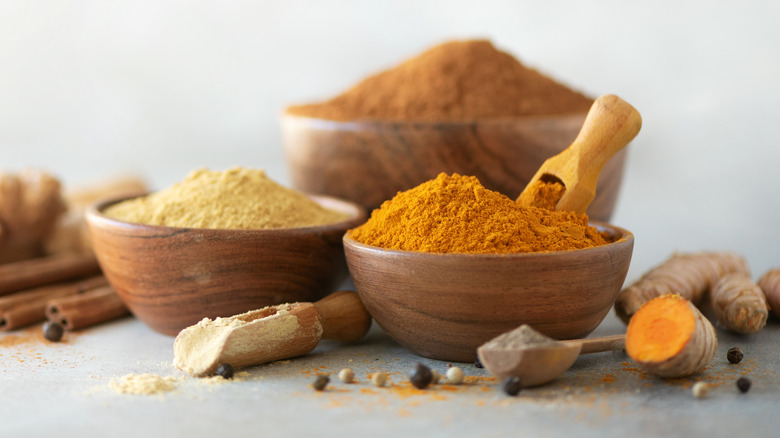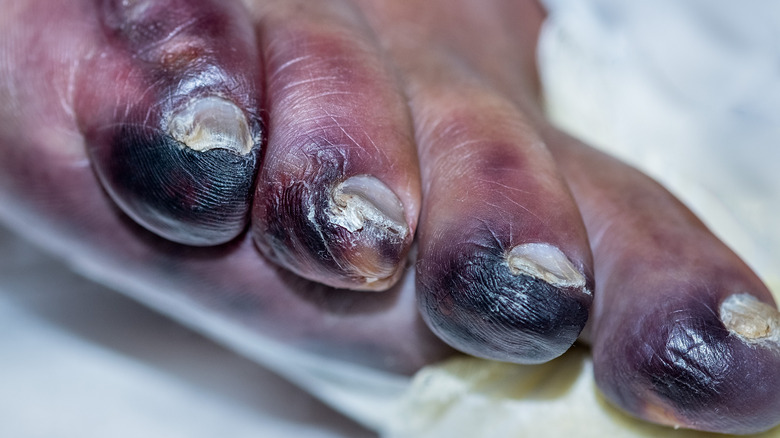Raynaud's Syndrome Explained: Causes, Symptoms, And Treatments
Raynaud's syndrome is a condition in which small blood vessels in the extremities constrict in response to cold or stress, restricting blood flow to the skin and causing the fingers and toes to become cold and numb (via Mayo Clinic). Raynaud's is more common among women and in people residing in cold climates.
Reynaud's syndrome (also known as Raynaud's phenomenon or disease) either occurs on its own (primary Raynaud's) or is caused by a separate underlying health condition (secondary Raynaud's), per StatPearls. It derives its name from Maurice Raynaud, who first described the condition in 1862. Mechanisms that play a role in Raynaud's include diminished blood flow due to constricted blood vessels, inflammatory and immune responses, and responses from the nervous system. A diagnosis of Raynaud's is made from symptoms, a medical history, and physical exam. Tests such as nailfold capillary microscopy may be used to distinguish between the two forms of Raynaud's.
Raynaud's symptoms can be controlled with lifestyle changes. Treatment depends on the frequency and severity of symptoms and may include medications that dilate blood vessels. In severe cases, surgery can be used to remove nerves that signal blood vessels to constrict. While the outlook for primary Raynaud's is generally very good, the prognosis for secondary Raynaud's is dependent upon the underlying disease (via Medscape).
Types of Raynaud's syndrome
According to the Cleveland Clinic, Reynaud's syndrome can be classified into two main categories: primary or secondary. Primary Raynaud's syndrome is more common, but the cause is unknown. Symptoms are generally mild and may include changes in skin color, numbness, and pins and needles. Since it is not associated with any underlying condition, primary Raynaud's is managed with lifestyle changes. Secondary Raynaud's is less common, and is caused by an underlying condition, medication, or lifestyle factor. While symptoms can be mild, secondary Raynaud's can also cause more severe symptoms such as skin ulcers or gangrene. Treatment involves medicines and various procedures that target the underlying cause.
As noted by the National Institute of Arthritis and Musculoskeletal and Skin Diseases, primary Raynaud's is most prevalent in people under the age of 30, and usually begins development during the teenage years. It is more commonly observed in women, and is likely driven primarily by genetic factors, since a family of history of Raynaud's increases the risk of getting the disease. Secondary Raynaud's occurs together with various diseases such as lupus, rheumatoid arthritis, and thyroid diseases. It is also linked to some medications (e.g., meds for high blood pressure and migraines) and work-related conditions (such as cold, chemicals, and the use of vibrating power tools).
Prevalence of Raynaud's syndrome
Primary Raynaud's syndrome comprises 80% to 90% of Raynaud's cases, via a study published in a 2013 edition of BMJ Clinical Evidence). According to a 2015 systematic review of studies published in BMJ Open, about 1 in 20 people in the general global population is living with primary Raynaud's. The mean incidence — proportion of people who develop primary Raynaud's — in the general world population is 1 in 400 annually.
Raynaud's is much more common in women, with a prevalence rate 20 times that of men. This may be attributed to an association between Raynaud's and estrogen replacement therapy found in some of the studies. In addition to female gender, Raynaud's has been found to be associated with migraine, smoking, cardiovascular disease, and manual labor.
Among countries, Japan has the lowest overall prevalence at 1.6 %, while the U.S. registers the highest prevalence with a median of 7.5%. However, different diagnostic criteria may account for different prevalence rates between countries. In terms of numbers, approximately 15 to 30 million Americans have Raynaud's, reports the Raynaud's Association. However, only 10% of people in the U.S. with Raynaud's pursue treatment.
What are the symptoms of Raynaud's syndrome?
Symptoms of Raynaud's syndrome vary from person to person, reports Johns Hopkins Medicine. Among the common symptoms are changes in skin color from pale or white to blue to red due to reduced blood flow. Upon warming, the hands may become swollen and painful as blood flow returns. In severe cases, sores can develop on the tips of the fingers or toes; rarely, lack of oxygen from poor blood flow can lead to gangrene (tissue death) and the risk of infection or amputation.
Apart from the fingers and toes, Raynaud's can spread to other areas of the body, including the face, ears, knees, and nipples (via StatPearls). Another symptom of Raynaud's is livedo reticularis, a skin condition that results from clots in small blood vessels. It manifests as a weblike pattern of purplish skin discoloration. Levido reticularis is alleviated by rewarming; however, it is irreversible when it's caused by another coexisting condition (such as vasculitis or peripheral vascular disease).
Causes of Raynaud's syndrome
While the exact underlying cause of primary Raynaud's syndrome is uncertain, the mechanism for its development has been described (via StatPearls). When the nervous system detects cold temperatures, it releases chemical messengers called neuropeptides as well as the hormone norepinephrine, both of which cause constriction of blood vessels and reduced blood flow to the skin. This normal response of the body conserves heat and maintains the core body temperature. In people with Raynaud's, however, an exaggerated response to the environment occurs, resulting in excessive constriction of blood vessels. In addition to cold temperatures, emotional stress also triggers this abnormal response that causes blood vessels to narrow for a prolonged period.
As reported by Medical News Today, secondary Raynaud's usually results from an underlying disorder such as atherosclerosis, primary pulmonary hypertension, and Buerger's syndrome (inflammation of blood vessels in the hands and feet). Other conditions linked to Raynaud's include connective tissue disorders such as scleroderma (hardened skin), lupus, rheumatoid arthritis, and Sjogren's syndrome (dry eyes and dry mouth). Various medications (e.g., beta blockers, migraine meds, ADHD meds, chemo drugs, over-the-counter cold remedies) as well as toxic substances such as tobacco smoke and vinyl chloride (air pollutant) can increase the risk of Rainaud's. Carpel tunnel syndrome and injuries such as frostbite and a fractured wrist can trigger Raynaud's as well. Lastly, repetition (e.g., typing, playing a musical instrument) and vibration (e.g., using a drill, jackhammer, or power saw) have also been connected to Raynaud's.
Raynaud's syndrome triggers
Exposure to cold temperature is a major trigger of a Raynaud attack, notes UpToDate. The temperature does not need to be bone-chilling cold, as even slightly cold exposures (e.g., air-conditioned spaces or the refrigerated food aisles in a grocery store) can precipitate an attack. Other cold triggers include holding a cold drink or glass of ice water, reaching into a freezer, and sweat that cools on the skin (via the Cleveland Clinic).
As explained in a 2022 review of studies published in the journal Cureus, emotional stress is another primary trigger of Raynaud attacks, suggesting the involvement of the central nervous system. In one of the studies, about one-third of Raynaud attacks were provoked by emotional stress. This is not unexpected, since emotional stress causes rapid heartbeat and blood vessel constriction in the toes and fingers of healthy people without Raynaud's. Apparently, the normal stress response whereby the body adapts and becomes desensitized to repeated exposures to stressors is impaired in people with Raynaud's. Rather than progressively decreasing, the stress response (blood vessel constriction) in people with Raynaud's persists. Easing of emotional stress and anxiety can reduce the frequency of the onset of Raynaud attacks.
How doctors diagnose Raynaud's syndrome
Taken together, symptoms, a medical history, and a physical examination are used to diagnose Raynaud's syndrome, according to the National Institute of Arthritis and Musculoskeletal and Skin Diseases. This may include an account of a typical Raynaud's attack or an inspection of nailbeds using nailfold capillary microscopy. In this test, a microscope is used to evaluate the small blood vessels (capillaries) in the nailfold – the fold of skin at the base of the fingernail. Abnormal capillaries may be an indication of secondary Raynaud's.
Typically, as Raynaud's initially attacks a single finger and then symmetrically spreads across the fingers on both hands, the thumb is spared (via StatPearls). Should the attack extend to the thumb, secondary Raynaud's may again be implicated. A differential diagnosis can distinguish Raynaud's from other similar conditions. These disorders include occlusive peripheral vascular disease, peripheral neuropathy, excessive cold sensitivity, and acrocyanosis (blueness of the hands and feet).
A definitive diagnosis of Raynaud's can be made from various blood tests, reports Healthline. The cold stimulation test utilizes a device attached to the fingertip that records the time it takes for the finger's temperature to return to normal body temperature after being exposed to cold. The antinuclear antibody test (ANA) can be used to screen for autoimmune diseases (e.g., scleroderma, rheumatoid arthritis) that are associated with Raynaud's. Meanwhile, the erythrocyte sedimentation rate (ESR) and C-reactive protein (CRP) are biomarkers that increase with the presence of active inflammation in the body.
Treating Raynaud's syndrome with medicine
The goals of treatment for Raynaud's include prevention of Raynaud attacks and lessening of their severity, while also improving quality of life (via the Cleveland Clinic). In cases of secondary Raynaud's, treatment should target the underlying condition and the prevention of skin ulcers and tissue damage.
While lifestyle changes are usually sufficient to manage mild forms of Raynaud's, medication may be needed to treat severe symptoms. Calcium-channel blockers can limit the number of Raynaud attacks as well as their intensity by dilating (widening) small blood vessels in the hands and feet, thus improving blood flow. These drugs can promote healing of skin ulcers in the extremities as well. As reported by Medical News Today, other specific medications used to dilate blood vessels include losartan, sildenafil (Viagra), fluoxetine (Prozac), and prostaglandin. Another class of medications known as alpha blockers oppose the action of norepinephrine in constricting blood vessels. Nitroglycerin — commonly used to prevent angina — can be administered as an ointment applied to the affected areas to enhance blood flow and cardiac output.
Nerve surgery is an option for very severe cases of Raynaud's. A sympathectomy involves cutting nerves of the sympathetic nervous system to prevent blood vessel constriction. Nerve signaling can also be blocked with chemical injections of local anesthetics or Botox. However, these chemical treatments need to be recurring, since the effects are only temporary.
Managing Raynaud's with lifestyle changes
Lifestyle changes can minimize the occurrence and severity of Raynaud attacks, explains the National Institute of Arthritis and Musculoskeletal and Skin Diseases. For starters, keeping warm and limiting exposure to cold temperatures is important. When being out in the cold is unavoidable, wearing a hat/hood, gloves, and several layers of clothing to keep the entire body warm (and not just the hands and feet) is essential. A sweater or jacket should be accessible even in air-conditioned indoor areas.
Meanwhile, smokers should seek medical help to explore ways to quit, as nicotine constricts blood vessels and may trigger an attack. A medical consult is suggested to discuss the use of medications that can induce a Raynaud attack. These drugs include decongestants and appetite suppressants that contain pseudoephedrine, migraine medications that contain ergotamine, and some stimulants for attention deficit-hyperactivity disorder. Managing stress with regular exercise, meditation, or deep breathing can improve overall wellness, notes the Cleveland Clinic.
Suggestions for avoiding Raynaud triggers include eliminating caffeine, always wearing socks indoors and two pairs outdoors in cold conditions, using a holder or insulating sleeve to handle cold drinks, periodically rubbing hands together, and wearing oven mitts when reaching into a refrigerator or freezer. Limiting the use of vibrating tools, using moisturizers on skin to prevent dry and cracked skin, and minimizing time spent in air-conditioned places are additional measures that can help protect against Raynaud attacks.
Alternative remedies for Raynaud's syndrome
Various alternative strategies may help in managing Raynaud's, reports the Mayo Clinic. Acupuncture may alleviate Raynaud attacks by stimulating better circulation. Biofeedback is a mind-body therapy that involves different muscle-relaxing methods and helps to control normally involuntary bodily functions, including body temperature. For Raynaud's patients, increasing the temperature of the hands and feet may reduce the frequency and severity of attacks.
According to a 2018 review of studies in the Journal of Alternative and Complementary Medicine, herbal medicine may potentially be used as safe and effective treatment for Raynaud's. For example, cinnamon increases blood flow, particularly in the fingers and toes. In traditional medicine, cinnamon was used by people in India, Europe, and East Asia for its warming effects during cold conditions. Ginger is another common herb that can stimulate circulation. Traditionally, ginger was used to treat "internal cold" characterized by cold hands, a faint pulse, and pale skin. Additionally, ginkgo supplements could decrease the frequency of Raynaud attacks, while fish oil may improve cold tolerance.
As described in a 2019 study in Frontiers in Pharmacology, Pycnogenol (the trademarked name) is a pine bark extract that has been used in traditional medicine (dating back to Hippocrates) to treat wounds. It has both antioxidant and anti-inflammatory properties. A 2019 pilot study in Minerva Cardioangiologica showed that 4 weeks of supplementation with Pycnogenol in patients with mild, primary Raynaud's was more effective than standard management in reducing symptoms such as coldness and burning pain.
Raynaud's syndrome complications
Generally, primary Raynaud's is not associated with complications, notes a 2013 study published in BMJ Clinical Evidence. People with primary Raynaud's who develop do develop complications such as severe ischemia (restricted blood flow) should be evaluated to identify secondary causes. In other words, complications in people with primary Raynaud's likely indicate that they transitioned to secondary Raynaud's. This transition occurs in 1% to 2% of people with Raynaud's on a yearly basis.
As described by Medical News Today, Raynaud's can cause chilblains, patches of skin that become red and irritated. Other symptoms of these skin lesions include a burning sensation and tenderness. Though they usually heal within 1 to 2 weeks, chilblains can recur. However, worsening of chilblains together with prolonged and extensive blood flow restriction can potentially lead to deformed fingers and toes. If a condition develops in which oxygen is entirely absent, skin ulcers and gangrene may result, followed by amputation of the affected finger or toe.
Prognosis of Raynaud's syndrome
For people living with primary Raynaud's syndrome, the outlook is usually very positive, as Raynaud's is neither life-threatening nor debilitating (via Medscape). In a Swedish population, the annual rate of remission was 4.4% in women and 5.5% in men.
As noted by Johns Hopkins Medicine, Raynaud's is more of an annoyance rather than a dangerous illness. However, due to their underlying condition (e.g., scleroderma, lupus), it may be more challenging for people with secondary Raynaud's to weather attacks. People diagnosed with Raynaud's usually have it for life (via Harvard Health Publishing). For the most part, Raynaud's does not worsen. In severe cases, however, ulcers that are slow to resolve may develop in impacted areas.
A Raynaud attack may also be the first manifestation of a rheumatic disease. Rheumatic diseases (e.g., rheumatoid arthritis) are autoimmune and inflammatory disorders whereby the immune system malfunctions and mistakenly attacks certain vital parts of your body (via the Mayo Clinic). Thus, it's important that people with Raynaud's be evaluated and tested to identify an associated rheumatic disease as early as possible.

